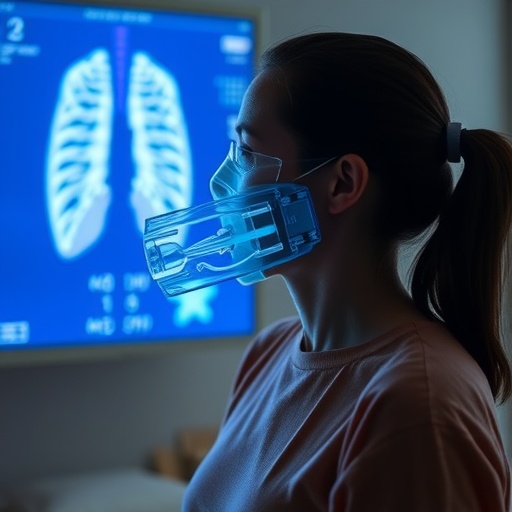A groundbreaking multicenter study from Spain is poised to revolutionize the early detection of Chronic Obstructive Pulmonary Disease (COPD) through the use of blood-based metabolomic biomarkers. Spearheaded by researchers at Hospital del Mar and its associated research institute, the investigation has identified specific alterations in blood metabolites that could serve as reliable indicators for COPD. This advancement offers a promising alternative to traditional diagnostic methods, enabling earlier identification and intervention in populations at risk.
COPD remains a significant global health challenge, characterized by progressive airflow limitation and respiratory symptoms caused by airway and/or alveolar abnormalities. Despite its prevalence, an estimated 70% of COPD cases go undiagnosed, largely due to the complexities involved in administering the gold standard diagnostic tool, spirometry, on a large scale. Spirometry requires specialized equipment and technical expertise, making widespread screening infeasible, especially in resource-limited settings.
Recognizing these limitations, the Spanish research consortium undertook a comprehensive metabolomic analysis involving 182 participants, split evenly between confirmed COPD patients and healthy control subjects. Using state-of-the-art mass spectrometry, the team quantified over 360 different metabolites in plasma samples, enabling a deeper insight into the molecular disturbances present in COPD.
.adsslot_zw9KrXId7U{width:728px !important;height:90px !important;}
@media(max-width:1199px){ .adsslot_zw9KrXId7U{width:468px !important;height:60px !important;}
}
@media(max-width:767px){ .adsslot_zw9KrXId7U{width:320px !important;height:50px !important;}
}
ADVERTISEMENT
Harnessing the power of artificial intelligence, the researchers refined this extensive dataset to isolate the ten most predictive metabolites that differentiate COPD patients from healthy individuals. This targeted biomarker panel achieved remarkable diagnostic performance, boasting sensitivity and specificity rates exceeding 90%. Such accuracy not only underscores the robustness of these metabolic signatures but also underscores their potential utility in clinical diagnostics.
Functionally, the identified metabolites are intricately linked to critical biological pathways such as cellular energy metabolism and lipid regulation. Energy metabolism disruptions may elucidate the profound fatigue and exercise intolerance commonly reported by COPD sufferers, while lipid metabolism alterations could have implications for associated cardiovascular comorbidities frequently observed in this population. This dual connection highlights the systemic nature of COPD beyond its pulmonary manifestations.
The streamlined selection of a limited group of metabolic markers paves the way for incorporation into routine blood testing. Unlike spirometry, a simple venipuncture followed by standardized analysis can be easily implemented in diverse healthcare settings, drastically lowering barriers to early COPD detection. This approach aligns with contemporary precision medicine paradigms, wherein biomarker-driven screening optimizes patient stratification and individualizes care trajectories.
Critically, early diagnosis through these metabolomic tools would enable prompt initiation of therapeutic interventions, potentially altering disease progression trajectories. It would also facilitate enhanced surveillance of comorbid conditions, thereby improving overall patient outcomes and quality of life. Given that late-stage COPD is often refractory to treatment, the implications for healthcare resource optimization are profound.
While these findings are compelling, the research team acknowledges the necessity of validating these biomarkers in larger, ethnically diverse cohorts to ascertain their generalizability and long-term prognostic value. Such validation studies are pivotal to ensuring that the biomarker panel performs consistently across varied clinical contexts and demographic populations.
Upon successful replication and validation, these metabolomic markers could be integrated into clinical practice guidelines, revolutionizing COPD screening protocols globally. The potential to shift from symptomatic diagnosis towards proactive detection embodies a transformative leap in respiratory medicine, potentially reducing COPD-related morbidity and mortality.
This study exemplifies the synergy of cutting-edge analytical technologies, computational biology, and clinical expertise converging to address unmet medical needs. It reflects a broader trend of leveraging metabolomics and artificial intelligence to decode complex disease phenotypes, thus opening new frontiers in disease biomarker discovery.
The reported research was published in the International Journal of Molecular Sciences on May 9, 2025, highlighting its contemporary relevance and significance in the field of respiratory medicine. As the scientific community awaits further developments, this study injects optimism into the quest for accessible and effective COPD screening modalities.
For patients, clinicians, and healthcare systems alike, the prospect of a simple blood test supplanting the cumbersome and often inaccessible spirometry represents a paradigm shift. It underscores the evolving landscape of diagnostic medicine focused on early detection and individualized treatment pathways.
In summary, the identification of ten metabolomic biomarkers with high diagnostic accuracy heralds a new era in COPD management. By facilitating early and precise detection through routine blood analysis, this innovation could dramatically improve patient outcomes and reduce the global burden of this debilitating disease.
Subject of Research: Identification of metabolomic plasma biomarkers for early detection of Chronic Obstructive Pulmonary Disease (COPD)
Article Title: Metabolomic Plasma Profile of Chronic Obstructive Pulmonary Disease Patients
News Publication Date: 9-May-2025
Web References: https://doi.org/10.3390/ijms26104526
Keywords: COPD, metabolomics, biomarkers, population screening, spirometry, blood test, artificial intelligence, energy metabolism, lipid metabolism, respiratory diseases, early diagnosis, comorbidities
Tags: advancements in COPD screeningartificial intelligence in medical researchblood-based metabolomic biomarkerschallenges in COPD diagnosischronic obstructive pulmonary disease diagnosisCOPD early detectioninnovative COPD research methodsmetabolomic analysis for healthmulticenter study on COPDreliable indicators for COPDresource-limited settings in healthcarespirometry limitations for screening





